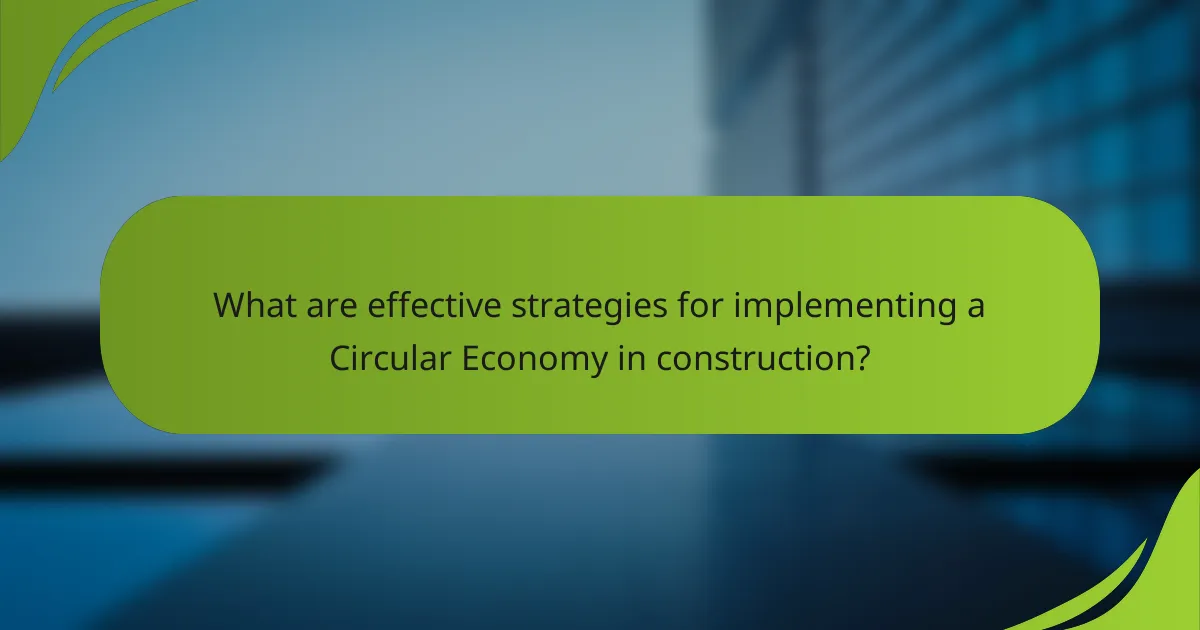The Circular Economy in Construction is a sustainable model that prioritizes resource efficiency and waste reduction by keeping materials in use for extended periods. This approach contrasts with the traditional linear economy, which follows a ‘take-make-dispose’ pattern. The article outlines the benefits of implementing circular practices, including significant reductions in waste, conservation of natural resources, and lower carbon emissions, with studies indicating potential reductions of up to 70% in greenhouse gas emissions by 2030. It further discusses effective strategies for adoption, such as sustainable design principles, stakeholder engagement, and the use of technology like Building Information Modeling (BIM) to enhance project efficiency and resource management.

What is the Circular Economy in Construction?
The Circular Economy in Construction is a sustainable model that emphasizes resource efficiency and waste reduction. It aims to keep materials in use for as long as possible. This approach contrasts with the traditional linear economy, which follows a ‘take-make-dispose’ pattern. In the circular economy, construction materials are reused, recycled, or repurposed. This model reduces environmental impact and conserves natural resources. Studies show that implementing circular practices can significantly lower carbon emissions in the construction sector. For example, the Ellen MacArthur Foundation reports that circular practices could reduce greenhouse gas emissions by up to 70% by 2030.
How does the Circular Economy differ from traditional construction practices?
The Circular Economy differs from traditional construction practices by prioritizing resource efficiency and waste reduction. Traditional construction often follows a linear model, where materials are used and disposed of without considering reuse. In contrast, the Circular Economy emphasizes designing for longevity, repairability, and recyclability. This approach aims to create closed-loop systems that minimize environmental impact. For instance, materials are sourced sustainably and repurposed at the end of their life cycle. Research indicates that adopting circular principles can significantly reduce construction waste, which accounts for approximately 30% of total waste generated globally.
What are the key principles of the Circular Economy in construction?
The key principles of the Circular Economy in construction include designing for longevity, minimizing waste, and promoting material reuse. Designing for longevity ensures that buildings and materials are created to last longer, reducing the frequency of replacements. Minimizing waste involves optimizing resource use and reducing excess materials during the construction process. Promoting material reuse encourages the recovery and repurposing of materials from deconstructed buildings. These principles aim to create a sustainable construction industry that conserves resources and reduces environmental impact. The Ellen MacArthur Foundation highlights that adopting these principles can lead to significant reductions in carbon emissions and resource consumption in the construction sector.
How does the Circular Economy impact resource management in construction?
The Circular Economy significantly enhances resource management in construction by promoting the reuse and recycling of materials. This approach minimizes waste and reduces the demand for new resources. According to a report by the Ellen MacArthur Foundation, implementing circular principles can lead to a 30% reduction in material costs. By designing buildings for disassembly, materials can be reclaimed and repurposed at the end of their life cycle. This not only conserves resources but also lowers carbon emissions associated with material extraction and production. Additionally, the circular model encourages innovation in material sourcing and construction techniques. For example, using reclaimed wood or recycled concrete can create sustainable building practices. Overall, the Circular Economy fosters a more efficient and environmentally friendly construction industry.
Why is the Circular Economy important for the construction industry?
The Circular Economy is important for the construction industry because it promotes resource efficiency and waste reduction. This approach minimizes the use of finite resources and encourages recycling and reusing materials. In construction, traditional methods often lead to significant waste, with approximately 30% of materials ending up as waste. The Circular Economy aims to close this loop, enhancing sustainability. It also fosters innovation in design and construction processes. By adopting circular principles, construction companies can reduce costs and improve their environmental impact. Studies show that implementing circular practices can lead to a 20-30% reduction in resource consumption. This shift is essential for meeting global sustainability goals and addressing climate change challenges.
What environmental benefits does the Circular Economy provide?
The Circular Economy provides significant environmental benefits by promoting resource efficiency and waste reduction. It minimizes the extraction of raw materials through recycling and reusing existing materials. This approach leads to lower greenhouse gas emissions compared to traditional linear models. Studies show that implementing circular practices can reduce carbon emissions by up to 70% in construction projects. Additionally, it conserves natural resources, preserving biodiversity and ecosystems. The Circular Economy also encourages sustainable product design, which results in longer-lasting materials. These practices enhance overall environmental sustainability in the construction sector.
How does the Circular Economy contribute to economic sustainability?
The Circular Economy contributes to economic sustainability by promoting resource efficiency and waste reduction. It emphasizes the reuse, recycling, and repurposing of materials. This approach minimizes the extraction of new resources, thereby conserving natural capital. According to the Ellen MacArthur Foundation, transitioning to a circular economy could generate $4.5 trillion in economic benefits by 2030. It encourages innovation in product design, leading to longer-lasting and more efficient products. Additionally, it fosters local economies by creating jobs in recycling and repair sectors. Overall, the Circular Economy enhances economic resilience by reducing dependency on finite resources.

What are the core benefits of implementing a Circular Economy in construction?
Implementing a Circular Economy in construction offers several core benefits. It significantly reduces waste by promoting recycling and reusing materials. This approach conserves natural resources and minimizes the environmental impact of construction activities. It also enhances economic efficiency through cost savings on materials and waste disposal. Furthermore, a Circular Economy fosters innovation in design and construction methods. It encourages the development of sustainable products and practices. Studies indicate that adopting circular principles can lead to a 30% reduction in resource consumption in construction projects. Overall, these benefits contribute to a more sustainable and resilient construction industry.
How does the Circular Economy enhance resource efficiency?
The Circular Economy enhances resource efficiency by promoting the continuous use of resources. It minimizes waste through the design of products for reuse, repair, and recycling. This approach reduces the demand for new raw materials. According to the Ellen MacArthur Foundation, implementing circular practices can lead to a 70% reduction in resource consumption. The Circular Economy also encourages innovation in materials and processes. This results in more sustainable construction practices. By closing the loop in production, it ensures that materials remain in circulation. This ultimately leads to lower environmental impact and increased economic benefits.
What specific materials can be reused or recycled in construction?
Concrete, steel, wood, bricks, and glass can be reused or recycled in construction. Concrete can be crushed and repurposed as aggregate. Steel is highly recyclable and can be melted down for new products. Wood from deconstructed buildings can be reused for framing or flooring. Bricks can be cleaned and reused in new structures. Glass can be recycled into new glass products or used in concrete mixes. These practices reduce waste and promote sustainability in construction.
How does resource efficiency affect project costs?
Resource efficiency significantly reduces project costs. Efficient use of materials minimizes waste and lowers procurement expenses. This leads to cost savings in both labor and transportation. According to a study by the World Economic Forum, resource-efficient projects can save up to 30% in costs. Additionally, optimizing energy consumption during construction can further decrease operational costs. Efficient resource management also mitigates risks of project delays, which can incur additional costs. Overall, improved resource efficiency directly correlates with lower project expenditures.
What social benefits arise from adopting a Circular Economy in construction?
Adopting a Circular Economy in construction provides significant social benefits. It enhances community engagement by promoting local resource use and collaboration. This approach creates job opportunities in recycling, refurbishment, and sustainable practices. It also fosters social equity by ensuring access to affordable housing through efficient resource management. Furthermore, it improves public health by reducing waste and pollution in urban areas. Studies show that communities involved in circular practices experience increased social cohesion and resilience. Overall, the Circular Economy model supports sustainable development and improves quality of life for residents.
How does the Circular Economy promote community engagement?
The Circular Economy promotes community engagement by fostering collaboration among local stakeholders. It encourages community participation in sustainable practices. This includes recycling, resource sharing, and waste reduction initiatives. Such practices enhance local awareness and responsibility towards environmental issues. Moreover, community-driven projects create opportunities for dialogue and knowledge exchange. This engagement often leads to innovative solutions tailored to local needs. Studies indicate that communities involved in Circular Economy initiatives report higher levels of social cohesion. This sense of community strengthens collective action towards sustainable development goals.
What role does job creation play in the Circular Economy model?
Job creation is a fundamental aspect of the Circular Economy model. It fosters economic growth by generating new employment opportunities. The transition to a Circular Economy involves innovative practices that often require skilled labor. For example, recycling and waste management sectors expand as materials are reused and repurposed. According to a report by the Ellen MacArthur Foundation, transitioning to a Circular Economy could create 1.8 million additional jobs in Europe by 2030. This shift not only supports existing jobs but also encourages the development of new industries focused on sustainability. Thus, job creation plays a crucial role in driving the Circular Economy forward.

What are effective strategies for implementing a Circular Economy in construction?
Effective strategies for implementing a Circular Economy in construction include adopting sustainable design principles and optimizing resource use. Sustainable design principles encourage the use of renewable materials and energy-efficient practices. This approach reduces waste and environmental impact. Optimizing resource use involves reusing materials and minimizing waste during construction.
Additionally, engaging stakeholders throughout the project lifecycle enhances collaboration. This includes architects, contractors, and clients working together to prioritize circular practices. Implementing a waste management plan is also crucial. This plan should focus on recycling and repurposing construction waste.
Finally, leveraging technology, such as Building Information Modeling (BIM), can improve project efficiency. BIM allows for better planning and resource management. These strategies collectively contribute to a successful Circular Economy in construction.
How can construction companies transition to a Circular Economy model?
Construction companies can transition to a Circular Economy model by adopting sustainable practices. First, they should prioritize the use of renewable resources. This includes sourcing materials that are biodegradable or recyclable. Next, companies can implement waste reduction strategies during the construction process. For instance, reusing materials from deconstructed buildings minimizes waste.
Additionally, companies can design for disassembly. This allows for easier recycling and reuse of materials at the end of a building’s life. Investing in technology that tracks resource use can enhance efficiency. This data-driven approach helps identify areas for improvement.
Collaboration with suppliers is crucial. Establishing partnerships can ensure a steady supply of sustainable materials. Training employees on Circular Economy principles also fosters a culture of sustainability within the organization.
Finally, measuring progress through key performance indicators can help assess the effectiveness of these strategies. Research shows that companies adopting Circular Economy practices can reduce costs and improve their market position.
What steps should be taken to assess current practices?
Identify the current practices in construction related to the circular economy. Gather data on resource usage, waste generation, and recycling efforts. Evaluate the effectiveness of existing policies and regulations. Analyze stakeholder engagement and collaboration in circular initiatives. Conduct surveys or interviews with industry professionals for insights. Compare practices against best practices in the industry. Document findings to identify gaps and opportunities for improvement. Use this assessment to inform future strategies for enhancing circular economy practices in construction.
How can companies integrate circular practices into their supply chains?
Companies can integrate circular practices into their supply chains by adopting strategies that promote resource efficiency and waste reduction. This includes designing products for longevity and recyclability. Companies should also establish take-back programs to reclaim products at the end of their life cycle. Collaborating with suppliers to source sustainable materials is essential. Implementing closed-loop systems can help in reusing materials within the production process. Utilizing data analytics can optimize resource use and reduce waste. According to the Ellen MacArthur Foundation, businesses that embrace circular economy principles can reduce costs and improve sustainability.
What challenges do companies face when adopting Circular Economy practices?
Companies face several challenges when adopting Circular Economy practices. One major challenge is the lack of understanding and awareness of Circular Economy principles among stakeholders. This knowledge gap can hinder effective implementation. Another challenge is the need for significant upfront investment in new technologies and processes. Many companies may find it difficult to allocate the necessary resources. Regulatory barriers also pose challenges, as existing laws may not support Circular Economy initiatives. Additionally, supply chain complexities can complicate the transition to more sustainable practices. Companies often struggle to establish collaborative relationships with suppliers and partners. Resistance to change within the organization can further impede progress. Employees may be accustomed to traditional linear models and may require training to adapt. Finally, measuring the impact and success of Circular Economy practices can be challenging. Companies often lack the metrics needed to assess their performance effectively.
How can companies overcome financial barriers to implementation?
Companies can overcome financial barriers to implementation by leveraging innovative financing models. These models include public-private partnerships, which can share costs and risks. Additionally, companies can seek grants or subsidies from governmental programs that support sustainable practices. Engaging in collaborative projects with other firms can also spread financial responsibility. Furthermore, adopting a phased implementation approach allows companies to manage cash flow better. By demonstrating the long-term cost savings of circular economy practices, companies can attract investors. Research shows that businesses implementing circular economy strategies can reduce operational costs by up to 30%.
What regulatory hurdles must be addressed for successful transition?
Regulatory hurdles for successful transition in the circular economy in construction include outdated building codes. These codes often do not accommodate sustainable materials or practices. Additionally, waste management regulations may restrict the reuse and recycling of construction materials. Permitting processes can be lengthy and complex, hindering innovative practices. Environmental regulations may conflict with circular economy principles, making compliance challenging. Financial incentives for sustainable practices are often limited or unclear. Stakeholder engagement is crucial but can be difficult to navigate. Lastly, lack of standardization in circular practices can create confusion and inconsistency in implementation.
What best practices can be adopted for successful Circular Economy implementation?
Successful Circular Economy implementation requires adopting several best practices. First, prioritize designing for longevity and reuse. This reduces waste and extends the lifecycle of materials. Second, implement robust recycling systems. Efficient recycling processes ensure valuable materials are recovered and reused. Third, encourage collaboration among stakeholders. Engaging suppliers, manufacturers, and consumers fosters a shared commitment to sustainability. Fourth, invest in sustainable materials. Using eco-friendly materials minimizes environmental impact. Fifth, adopt a lifecycle approach. Assessing the entire lifecycle of products aids in making informed decisions. Lastly, monitor and measure progress. Tracking performance metrics helps identify areas for improvement. These practices collectively support the transition to a Circular Economy in construction.
How can collaboration with stakeholders enhance Circular Economy efforts?
Collaboration with stakeholders enhances Circular Economy efforts by fostering shared knowledge and resources. Stakeholders include manufacturers, consumers, and policymakers. Their diverse perspectives lead to innovative solutions for waste reduction. Collaborative initiatives can streamline material reuse and recycling processes. For instance, joint ventures can optimize supply chains to minimize waste. Research shows that collaborative projects in construction can reduce material costs by up to 30%. Additionally, partnerships can drive regulatory support for sustainable practices. Engaging stakeholders creates a collective commitment to sustainability goals. This approach ultimately leads to more effective Circular Economy strategies in construction.
What role does innovation play in achieving a Circular Economy in construction?
Innovation is crucial for achieving a Circular Economy in construction. It enables the development of sustainable materials and processes. Innovations such as modular construction and prefabrication reduce waste significantly. Advanced recycling technologies allow for the reuse of materials from deconstructed buildings. Digital tools improve resource management and project efficiency. Smart building technologies optimize energy use and reduce environmental impact. Research indicates that innovative practices can lead to cost savings and enhanced project performance. For instance, a study by the Ellen MacArthur Foundation highlights that circular practices can generate substantial economic benefits in the construction sector.
The Circular Economy in Construction is a sustainable model focused on resource efficiency and waste reduction, contrasting with traditional linear practices. This article explores the principles of the Circular Economy, its impact on resource management, and the significant environmental and economic benefits it offers to the construction industry. Key strategies for implementation, challenges faced by companies, and the role of innovation and collaboration in enhancing circular practices are also discussed. Overall, the article emphasizes the importance of adopting circular principles to create a more sustainable and resilient construction sector.